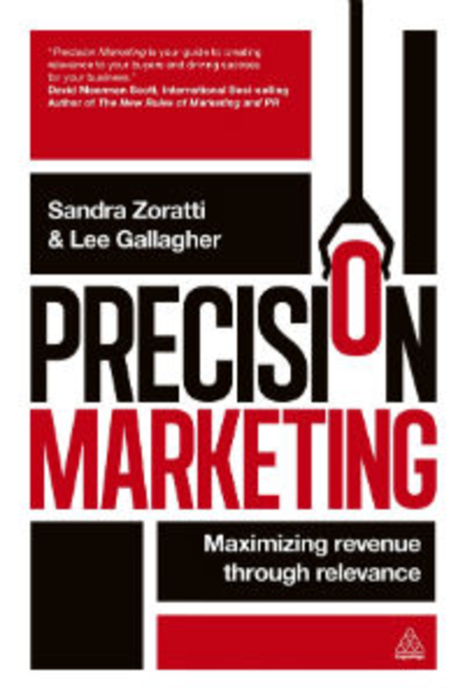“Relevant marketing drives revenue,” Sandra Zoratti stated emphatically during a recent discussion we had on the importance of relevance in marketing. “The question is, how do you get relevant?”
Zoratti, coauthor of Precision Marketing and vice president of marketing, executive briefings, and education for Ricoh, shared some insight into how to do just that.
Why is relevance so important in marketing today?
What consumers want is often not what marketers are providing. This means that marketers are missing an opportunity to build the kind of customer engagement that improves marketing performance. Relevant marketing can better engage customers; customer engagement is more elusive than ever—and is the best prize marketers can gain.
Consider these statistics: 50% of consumers disengage with brands because of irrelevance; 60% of marketing today is untargeted and not relevant. When marketers do take steps to target the right customers and be relevant to them, they see an average 2X return as measured in response, revenue, or ROI.
Generally speaking, why aren’t direct marketers as relevant as they could be?
Many marketers focus primarily on their success rate; for example, that 1% of a million customers responded to an offer. But what about the other 99%? Are those customers less likely to respond to future campaigns? More likely to opt out because they feel that the communications they’re receiving are irrelevant?
There are hidden costs that marketers aren’t measuring or aware of; for example, the negative impact of what they’re doing, or not doing. Just because that impact is hidden doesn’t mean that it doesn’t exist. Until you do that one campaign that’s highly relevant and targeted, you don’t know what’s missing or what it’s costing your business. In other words, what’s the cost of the 99 percent who say no?
Think about it another way: What’s the net gain of your marketing? That includes the negative costs. That’s what you need to start looking at.
What’s the solution?
Marketers can increase their relevance by leveraging data. Having scores of customer data is great. But it’s not the data that’s essential; it’s the insight that’s in that data. Start by performing simple analytics—what I call second-grade analytics—to get actionable data. Then target the right people, and send them the right message at the right time. Align your content and messaging, and then measure.
Start small. Select one campaign with one specific goal. Apply simple analytics, and then run a test versus control. Testing is absolutely a must. Otherwise you won’t know the uptick or difference in performance that the relevance provides. Once you have data showing the impact of relevant communications, then you’ll know that it makes sense to take the next step.
What’s holding marketers back?
Many marketers are hesitant to take that first step because all that data is daunting. But you don’t need Big Data and complex analytics do be relevant. Start with data that you do have. You can hit a home run with customers that competitors can’t touch.
Often marketers don’t know where to begin, so they have what’s well-known as analysis paralysis. That’s the worst thing that can happen. Don’t wait till the pain of losing customers or losing market share forces you to take action. Use basic analytics to uncover something you can take action on now and take that first step.
Another issue is the marketing–IT relationship. It needs to be collaborative. As does marketing’s relationship with sales and customer service. Integration is one of the most challenging things we face as marketers. We have to work across the organization to deliver relevant messaging and experiences to our customers today.
Trying to create integrated experiences across channels a priority for many marketers right now, but it’s so hard to do. Few do it well. One example I cite in the book is 1-800-Flowers.com. The company has put data at the core of its business. In doing so it’s provided one view of its customer across about a dozen brands. As a result, it delivers a more unified customer experience, designed to meet customers at their specific point of need.
For those whose marketing is relevant, what’s enabling them to be so relevant?
Like 1-800-Flowers.com, companies whose marketing is relevant to their customers are tapping into the power of their data. Caesar’s Entertainment is another example of a company that centralized its data and made it the foundation of all its marketing. Once the company had that holistic view of its customers it discovered that .15 percent of its customers generated 12 percent of its revenue. Any marketer would want to have that insight. Caesar’s used the information to design what I’ll call a white-glove program to engage those high-value customers. This now includes Good Luck Ambassadors, who will interrupt a top customer who [may be on a losing streak] and offer dinner or show tickets, based on their known preferences, to turn a potentially poor experience into a positive one. It’s a brilliant example. What do you do about what you’ve learned? You put the insight into action.
What benefits are these marketers gain over competitors whose marketing is less relevant?
Along with increases in response, revenue, or ROI, one big one is customer loyalty. In a challenging economy, customer retention is more important than customer acquisition; yet, most marketers’ budgets are spent primarily on acquisition. What’s more, customers’ fondness for using social media to comment on brands means relevance is imperative.
Ultimately, relevance helps with retention, which means that as relevant marketing increases customer engagement it also lowers marketing costs.








